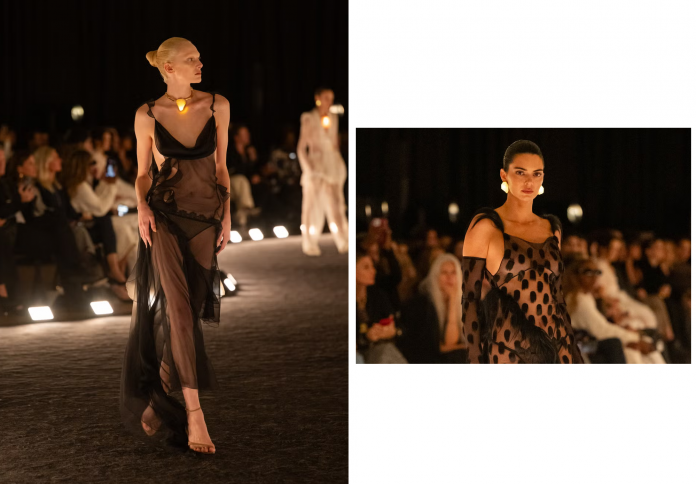Daniel Roseberry’s Schiaparelli Spring 2026 Ready-to-Wear collection, titled “Dancer in the Dark,” was an arresting study in sophisticated tension, finding perfect alignment between the house’s celebrated couture fantasy and commercial pragmatism. Presented in the Centre Pompidou, the collection moved away from viral spectacle toward a more internalized, commanding sensuality. Roseberry embraced the oxymoron of “hard chic”, using a restrained palette of black, bone white, and crimson to create garments that were disciplined yet fluid, sculptural yet intimate. The show was an invitation for the wearer to engage in a moment of private, liberated joy, proving that ready-to-wear, six years into his tenure, can be both exquisitely wearable and as emotionally arresting as a piece of fine art.
The Return to Parisian Gravitas
The Schiaparelli Spring 2026 collection marked a deliberate anchoring in Parisian elegance, dialing back the Americana and overt theatricality seen in previous seasons in favor of a profound, couture-infused gravitas. Roseberry sought to answer a timely question: how does a house defined by its haute couture grandeur translate that aura into clothing for everyday life without diluting its magic? The solution lay in extreme wearability fused with an extreme drama—a tension that makes the air leave the room.

The aesthetic was dictated by a tightly controlled, nocturnal palette of black, cream white, and a deep, sensual crimson. This restraint reinforced a mood of unflinching assurance and discipline, moving the focus from maximalist motifs to the purity of silhouette and cut. The effect was that of a powerful, commanding sensuality—not the wardrobe of a damsel, but of a woman who understands that her power is complex, layered, and often best expressed through quiet, devastating refinement.
The Dichotomy of Hard Chic
The core philosophy driving the tailoring was what Roseberry termed “hard chic”—a celebration of discipline found in sharp, clean-lined silhouettes. Precision-cut jackets with defined, though sometimes unconventionally positioned, shoulders were paired with tailored skirts and trousers that possessed an almost architectural sharpness. This was the foundation of the collection: rigor and control.

Yet, this severity was continually undermined by elements of sensual fluidity and abandon. Razor-sharp tailoring would be immediately followed by delicate sheer slips, bias-cut dresses, and soft mousseline gowns that glided across the runway. This balance between discipline and release captured the energy of “dancing in the dark”—a private, liberating moment where discipline gives way to pure, physical self-expression. The garments felt both structurally sound and entirely uninhibited, celebrating a feminine desire that is complex and unapologetically commanding.
Surrealism Internalized: The New Anatomy
While Schiaparelli is globally synonymous with surrealist iconography—eyes, hands, padlocks—Roseberry’s Spring 2026 collection saw these motifs recede into refinement and become seamlessly integrated into the garment’s DNA, rather than serving as literal embellishments. The surrealism became less about shock value and more about internalized wit and intellectual tension.

This shift was most intriguing in the collection’s take on the body. Knit dresses featured trompe l’oeil jacquards that sketched the contours of the nude female form, creating an intimate gesture of self-expression where the body itself was the drawing. Accessories also embraced this soft surrealism: the Secret padlock bag was reimagined in pliable, soft dimensions to recall Salvador Dalí’s melting clocks. The final result was an updated anatomical language where the question becomes: where does the body end, and where does wearable art begin?
Couture Techniques for Ready-to-Wear
Roseberry has always walked the fine line of being “too couture” for ready-to-wear, and in this collection, he fully embraced that friction as a strength. His goal was to make “fantasy made easy for daily life”. This translated into applying the highest level of atelier technique to pieces destined for a ready-to-wear rack.

A prime example was the homage to the archival “Tear Dress” from 1938, a collaboration with Dalí. Roseberry’s version was not painted silk, but actual cutouts and “rips” executed on delicate jersey, crystal mesh, and mousseline. This process—cutting and embroidering the edges of holes with crystals to simulate violence or decay—is a serious level-up in complexity, lending a couture-level charge to what are technically ready-to-wear pieces. The use of sculpted, crumpled rosettes rising from the shoulders of evening gowns, seemingly growing stiff and metallic along the body, further reinforced the idea of each garment carrying the weight and resolution of a museum exhibit.
The Accessory as Scupltural Statement
Accessories, as is traditional at Schiaparelli, were commanding statements in their own right, designed to delight and surprise. They continued the collection’s theme of sensual anatomy and organic fluidity. Shoes and hats looked almost pliable, as if the initial drawing had been brought directly into three-dimensional life without losing its raw, hand-sketched quality.
The most provocative pieces included new handbags that featured sculpted brass fingers clutching their sides, making the accessory feel as if it were a living entity being carried. Additionally, the jewelry was a major highlight, with salt lamp necklaces—lit by internal LED batteries—that cast a soft, glowing light, transforming a geological element into a surreal, intimate beacon of light in the Centre Pompidou’s dim setting. This confident integration of surrealist motifs into commercial yet ingenious products affirmed Roseberry’s vision: that true luxury lies not in excess, but in imagination without limits.










